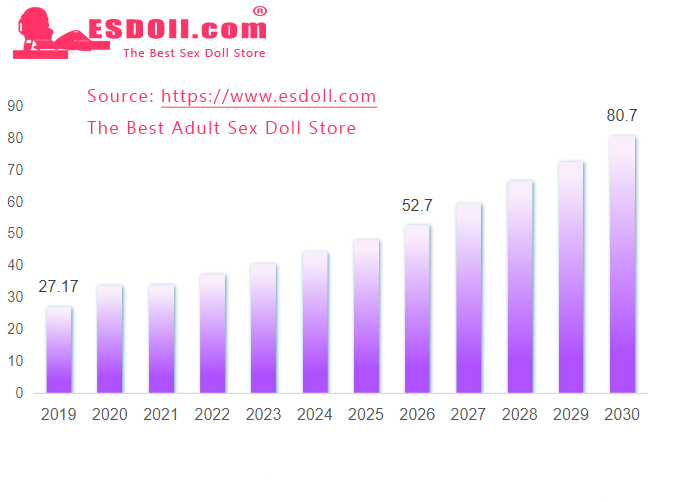As global attention increasingly focuses on the quality of sexual life and personalized needs, the sex toy market is experiencing unprecedented growth opportunities. According to the “2024 sex toy Market Insight Report” released by authoritative websites, the sex toy market is growing at an astonishing rate. It is projected that from 2019 to 2026, the global market size will increase from approximately $27.17 billion to $52.7 billion, with expectations to reach $80.7 billion by 2030. According to Business Research, the global sex toy market is expected to have a compound annual growth rate of 8.2% from 2021 to 2031.
Online e-commerce platforms have become the primary channels for consumers to purchase sex toy products. Data shows that in 2022, online channels accounted for 63.09% of the global sex toy market share. Additionally, it is projected that between 2022 and 2027, online sales of adult novelties will grow at a compound annual growth rate of 12.45%, reaching a market size of approximately $13.4 billion.
Amazon is noted as a major e-commerce platform in the global adult industry, generating around $10.365 billion in adult product gross merchandise volume (GMV) in 2023. Following Amazon are platforms like eBay and similar adult branded sex store websites like ES Doll, with GMVs of $5.504 billion and $1.431 billion respectively.
In terms of consumer demographics, the primary consumers of sex toy products are young adults aged 27 to 42. For example, in the United States, around 86% of adults in this age group own at least one sex toy. Furthermore, female consumers dominate the sex toy market, with a market share of 59.56% in 2022, expected to continue growing at a compound annual rate of 6.8% from 2023 to 2030.
Vibrator sex toys (including vibrating sex doll torso, vibrating pussy ass , and customized sex dolls etc) are the most popular category among consumers, with approximately 47% of Americans stating they own such products. sex toy specialty websites are the preferred purchasing channel for consumers, with around 55% choosing these sites for shopping.
Surveys indicate that about 24% of consumers do not purchase sex toy products primarily due to feeling embarrassed about owning such items. Additionally, religious and political factors can influence consumer purchases. Sixty percent of millennials state that providing discreet and anonymous packaging would increase their likelihood of purchasing a particular sex toy brand.
North America and Europe are the two major regions for the sex toy market. The North American market is expected to grow at a compound annual rate of 7.91%, reaching $20 billion by 2030. The European market also demonstrates strong growth momentum, expected to reach $16.4 billion by 2030.
The awakening of female consciousness is expanding the sex toy market, with more female consumers embracing the concept of self-pleasure. This has rapidly driven market growth, while the development of e-commerce platforms provides convenient sales channels for sex toy products, meeting people’s emphasis on privacy protection and further propelling market growth.
China holds a significant position in the global sex toy market, producing 70% of adult products worldwide. Chinese sellers provide high-quality and competitively priced sex toy products to global consumers, leveraging strong manufacturing and supply chain advantages, along with innovation in technologies like smart hardware and the Internet of Things.
Despite vast market prospects, the sex toy market faces challenges including market awareness, regulatory restrictions, marketing limitations, and challenges related to product quality and design. To address these challenges, companies need to continuously innovate adult product types, emphasize brand identity, and focus on environmentally safe products.


















